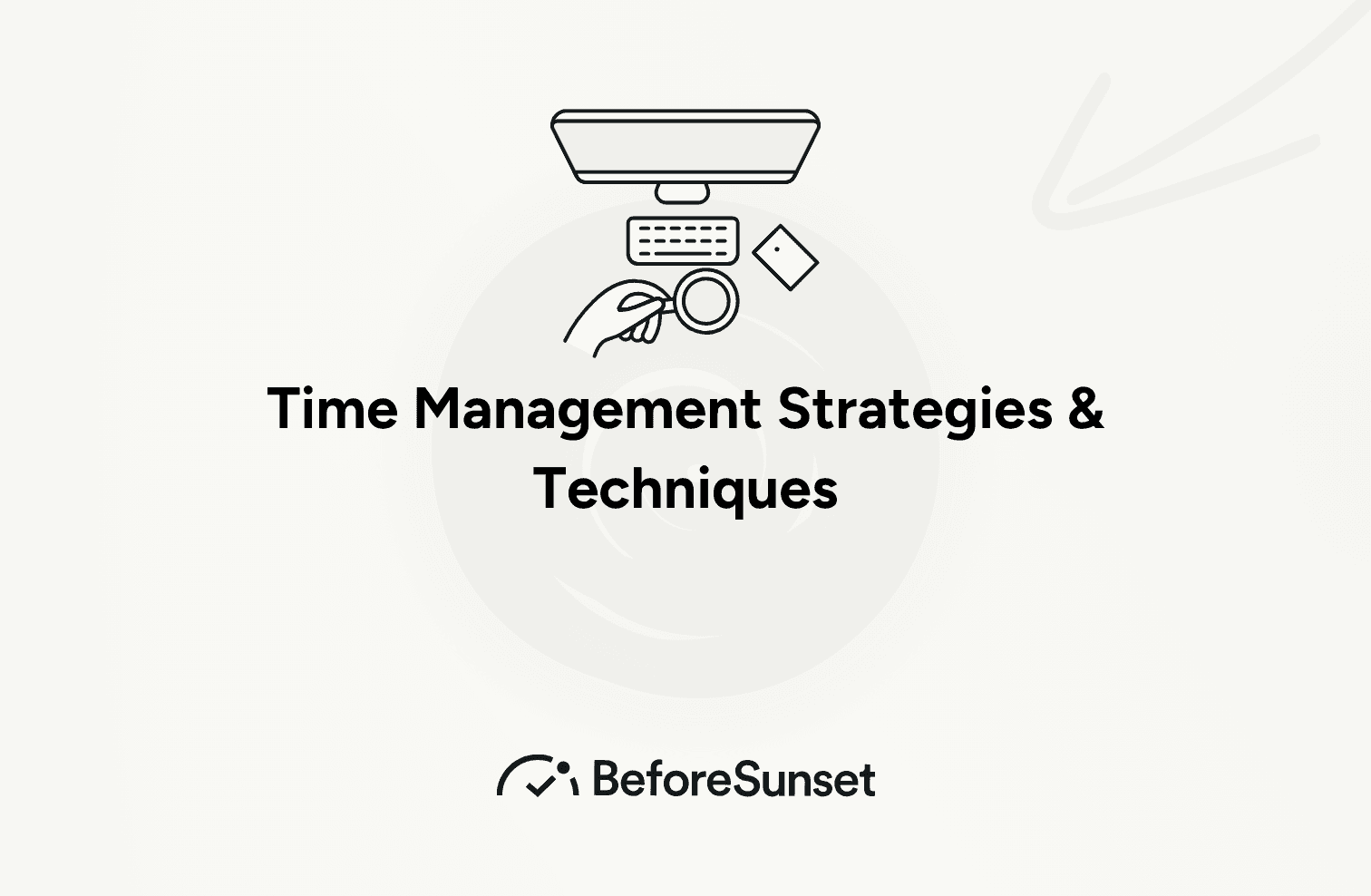Time management is a fact of life. We all need to manage our time effectively if we are going to survive in today's fast-paced world. Everybody has the same amount of time each day, but some people get a lot more done than others because they know how to use their time more effectively.
This blog offers 18 effective strategies and techniques that you can use to achieve your own work goals.
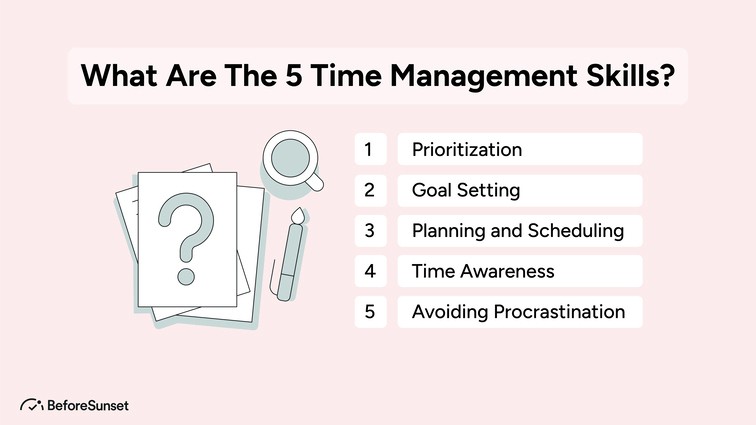
What Are The 5 Time Management Skills?
The following five methods of time management are essential, although there are many others.
Effective time management strategies require the ability to prioritize responsibilities. In order to avoid becoming sidetracked from the truly crucial work at hand, it is necessary to set priorities and focus on the most crucial activities first.
To plan is to make a schedule for the coming day, week, or month. It entails deciding how much time you have to devote to each activity and breaking down daunting endeavors into manageable chunks.
Setting goals entails deciding what it is you want to accomplish and developing a plan to get you there. If you possess this skill, you can maximize your efforts and accomplish more in less time. It's a plus because it helps you get pumped up and stay focused.
When important tasks are delegated to people who are better suited to complete them, efficiency and effectiveness are both increased. With this ability, you can prioritize your work and get more done in less time.
Time monitoring is the process of keeping tabs on how much time you spend on individual activities. It helps you maintain concentration throughout the day and offers advice on how to become more productive. The act of keeping track of one's time might reveal time wasters and prompt one to take corrective action. That is where effective time management strategies come into play.
What Are The 4 P's of Time Management?
The 4 P's of time management are a mnemonic that represent four essential elements to consider when managing your time effectively. These are:
Prioritize: Determine which tasks or activities are the most important and need to be addressed first. Use techniques like Eisenhower's Matrix (Urgent vs. Important) to categorize tasks based on their significance and urgency.
Plan: Create a structured plan for how you will allocate your time. Set clear goals and break them down into smaller, manageable tasks. Use tools like to-do lists, calendars, or time-blocking techniques to organize your schedule.
Punctuality: Being punctual means respecting and valuing your time and the time of others. Arriving on time for appointments, meetings, and deadlines is crucial for effective time management.
Prevent Procrastination: Procrastination can be a major hindrance to effective time management. It's essential to recognize and address procrastination tendencies by using strategies like setting deadlines, breaking tasks into smaller steps, and addressing the root causes of procrastination.
18 Time Management Strategies For Work
Be sure you're operating effectively if your to-do list is longer than your arm. Spending much of your day putting out fires and making lists of useless things is unproductive. Examine the 18 work-related time management techniques listed below, and decide which ones will enable you to finish your to-do list as quickly as possible. With these time management strategies finishing your never ending task list has never been easier.
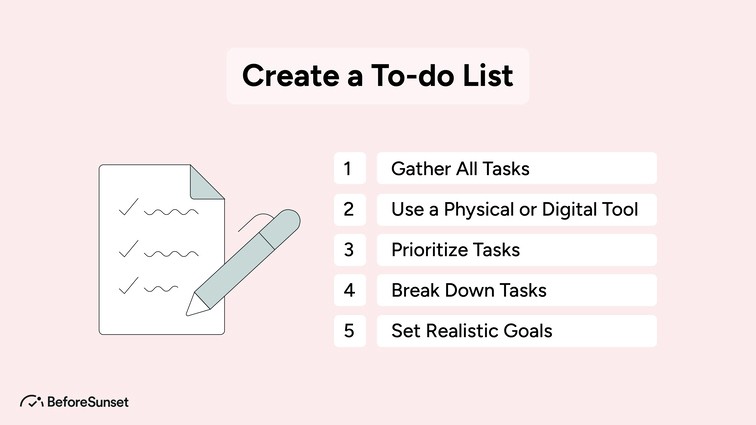
Create a to-do list
Making a to-do list is a simple yet effective time management tool that may help you keep focused and on target throughout the day. Here's an example of how to construct a useful to-do list:
Create a list of everything you need to do today to get things going. This might be completed the night before or first thing in the morning.
Rank the things on your list according to their importance and urgency. Give a number or letter to each task to indicate its importance.
Big projects should be broken down into smaller, easier-to-manage portions. This will make it easier to care for them and track your progress.
Decide how long you believe each task will take, and then arrange your day accordingly.
Check in with your to-do list numerous times during the day to ensure you are progressing and staying on track.
Once you've completed each thing on your list, cross it off. As a consequence, you'll feel more accomplished, which will motivate you to continue working on the other responsibilities.
Making a to-do list may help you focus on what has to be done while also keeping you motivated. You may also rapidly track your progress and make changes as needed.
Start your day with a plan
Making a plan for the day will help you remain on track and get more done during the day. Planning your day in advance is a straightforward but powerful time management technique. Spend a few minutes in the morning reviewing your to-do list and establishing priorities for the day so that you can start the day with a strategy.
Schedule the chores that are most crucial and urgent into your day. You may make a strategy to deal with any possible roadblocks or deterrents in advance by identifying them. You may decrease stress, boost productivity, and concentrate your attention on the most crucial activities by having a plan for the day before it begins.
Also, it enables you to stay in charge of your day and be more proactive with regard to time management. You may approach your task with more assurance and complete your objectives more quickly if you have a clear strategy in place.
Start with the highest-value task
An effective time management technique that can help you do more in less time is to start with the work that has the highest value. This tactic entails ranking your chores in order of importance and doing the most crucial ones first.
You may make great progress toward your goals and prevent becoming mired down in lower-priority chores by completing the most important work first. Due to the fact that you are working on activities that are important to you and have a big influence on your job, this technique also helps you maintain your motivation and attention.
Also, starting with the most important work decreases the likelihood of procrastination and aids in maintaining momentum throughout the day. After doing the most crucial assignment, you'll experience a feeling of success and have more energy to work on the other items on your to-do list.
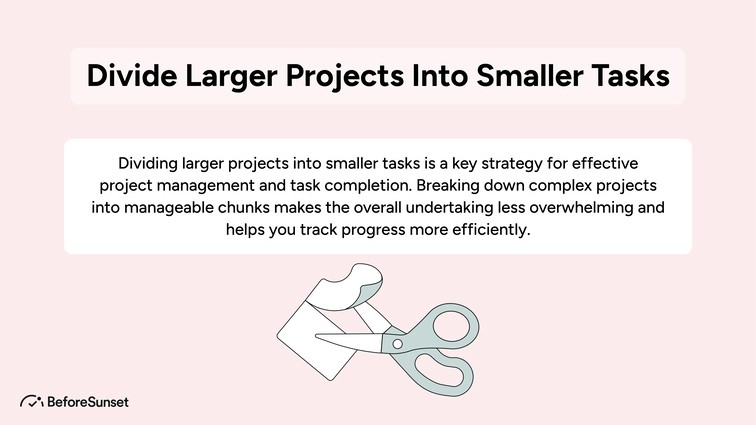
Divide larger projects into smaller tasks
One of the most important time management techniques that may keep you organized, focused, and effective is breaking up major jobs into smaller chores. Using this strategy, more challenging projects are divided into smaller, easier-to-manage activities that may be finished in a shorter amount of time.
By doing so, you may approach the job methodically and systematically and prevent feeling intimidated by its scope and complexity. You can measure your progress and maintain motivation as you accomplish each job by breaking a larger project down into smaller ones. You may better prioritize your important tasks and manage your time by using this time management technique.
Prioritize the most crucial and urgent jobs first, and then do the lesser, less crucial chores when time permits.
Limit distractions
Keeping yourself focused, increasing your productivity, and getting more done in less time may all be accomplished by limiting distractions. Email, social media, phone calls, and interruptions from coworkers are just a few of the many distractions that might occur.
You may take a few easy measures to reduce distractions, such as turning off notifications, setting aside specified times to check social media or email, using noise-cancelling headphones, and locking your office door. Distractions might keep you from concentrating on the subject at hand and hinder your ability to perform effectively.
This strategy also aids in preserving your sense of control over your workplace and preventing feelings of overload brought on by conflicting demands. You may attain flow and stay in the zone for extended periods of time by reducing distractions, which can boost productivity and give you a sense of success.
In the end, by employing this time management technique, you may work more productively and effectively by working smarter, not harder.

Pomodoro technique
The Pomodoro technique is a well-liked time management approach that may improve your concentration and productivity. With this method, you would divide your workday into 25-minute segments, or "Pomodoros," and take a five-minute break in between each segment.
You take a lengthier rest of 15 to 20 minutes after four Pomodoros. The goal is to work hard for a little amount of time before taking a break to relax and refuel. As you attempt to finish activities in a succession of reasonable intervals, the Pomodoro technique can help you stay motivated and focused.
You may prevent burnout and maintain your energy level throughout the day by taking frequent breaks. The most crucial and urgent activities may be scheduled at your most productive times using this strategy, which can also assist you in prioritizing your job.
Know how you spend your time
One of the most important time management techniques is to be aware of how you spend your time. This will enable you to see where your time is going and allocate it more wisely. This tactic is keeping track of your time for a predetermined amount of time, either manually or with the use of a time-tracking program.
By doing this, you may track how you spend your time and see any inefficiencies or places for improvement. Afterward, you may utilize this knowledge to adjust your schedule, for as by spending less time on low-value work or assigning chores to others.
Understanding how you spend your time also enables you to more efficiently set priorities for your job and manage your time more. Prioritize the most crucial and urgent jobs first, and then do the lesser, less crucial chores when time permits.
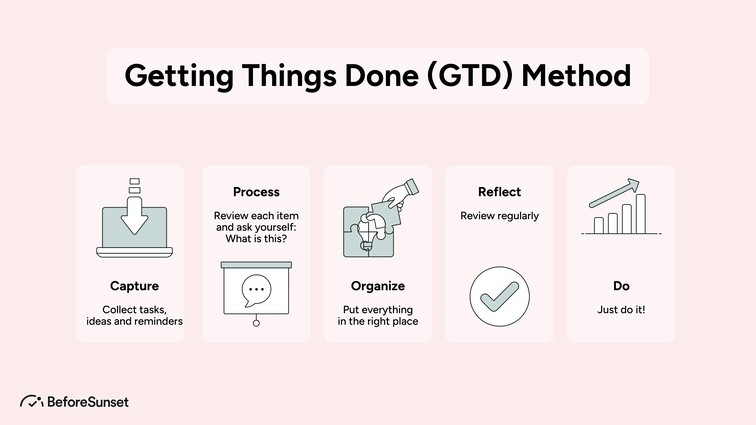
Getting things done (GTD) method
You may boost your productivity and lower your stress levels by using the complete time management technique known as the Getting Things Done (GTD) approach. This strategy is putting all of your thoughts, plans, and projects into a system outside of your head, classifying them according to their importance, and acting on them in a methodical and effective manner.
For each work or project, the GTD technique focuses on determining the next practicable step and breaking it down into smaller, more doable tasks. By doing this, you may keep your attention moving forward rather than being distracted by the magnitude and complexity of your assignment.
The GTD technique also highlights the need of keeping an orderly system in place to manage your chores and projects. This will help you remain on top of your work and lessen the chance that you'll forget or ignore crucial jobs.
Reduce meetings
Cutting down on meetings is an effective time management technique that may boost productivity and help you gain important time back. Attending too many meetings might cut into the time you have available for other crucial duties.
Meetings can be a huge time waster. You can start by reviewing your present meeting calendar and finding sessions that can be reduced or eliminated in order to minimize the number of meetings you attend.
Email, chat, and video conferencing are more options for interacting and working together. If you do have to organize a meeting, try to make it as concise and focused as you can by keeping in mind the goal, the agenda, and the participants.
You may enhance productivity and free up more time for crucial work by cutting down on the frequency and length of meetings. This strategy also aids in preserving your sense of control over your workplace and preventing feelings of overload brought on by conflicting demands.
End your day with housekeeping
Ending your day with housekeeping is a time management strategy that can help you wrap up your workday in an organized and efficient way. This approach involves taking a few minutes at the end of each day to review your to-do list, clean up your workspace, and prepare for the next day.
By doing this, you can ensure that you are starting the next day with a clean slate and a clear sense of what you need to accomplish. It can also help you reduce stress and increase your sense of control over your work.
Ending your day with housekeeping can also help you identify any outstanding tasks or issues that may require your attention the following day, allowing you to proactively address them and avoid any last-minute crises.
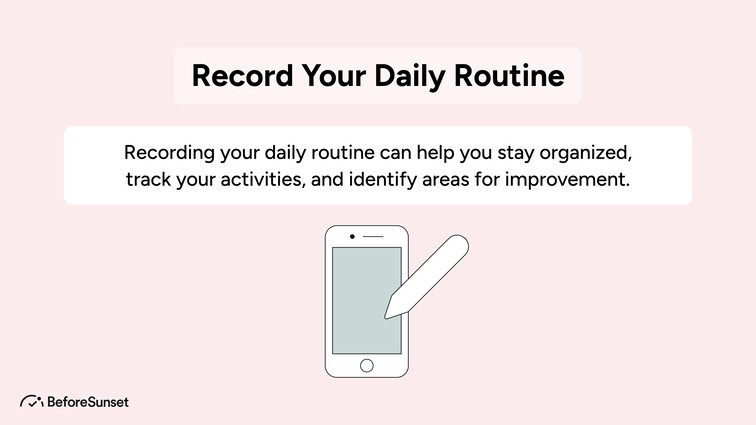
Record your daily routine
Keeping a journal of your work is a great method for seeing patterns and faulty habits. The ability to manage one's time in such a way is priceless. The key to success with this method is vigilantly monitoring your daily routine and making well-considered choices on how you spend your time.
The time wasters and diversions that have been holding you back from reaching your goals will become readily apparent. The next step is to rearrange your agenda to give priority to the activities that will help you reach your objectives and neglect those that are less important.
If you maintain a log of what you do each day, you can use that knowledge to make more precise plans and estimates for how long each task will take.
Reduce multitasking tasks
A time management strategy, less multitasking increases productivity while decreasing anxiety. Multitasking, in which you perform more than one activity at a time, has been demonstrated to lower productivity and raise error rates.
To reduce the amount of time spent multitasking, focus on one activity at a time and fight the temptation to switch between unrelated tasks. You may also arrange your tasks in terms of importance and urgency, focusing on completing one task before moving on to the next.
Limiting your use of multitasking can have positive effects on your health and happiness by lowering your stress and mental workload.
Batch similar tasks together
A time management tactic that can increase your productivity and efficiency is batching similar tasks together. With this strategy, jobs that are similar in nature or need for comparable equipment or resources are grouped together. Instead of jumping back and forth between various jobs throughout the day, you may set time to reply to emails, make calls, or do data entry chores.
By doing this, you may cut down on the time you spend redirecting your attention and moving between projects, which will enable you to do your work more quickly and accurately. Batching related jobs together can also help you maintain a certain frame of mind or way of thinking, which can enhance your performance all around and speed up work completion.
Get organized
An effective time management strategy that might help you be more efficient and productive at work is to become more organized. If you're not well-organized, you could squander time and energy looking for the resources you need to complete your tasks.
If you want to start being more organized, you may create a system for storing and retrieving your papers and other materials. Making folders and labeling papers may be necessary steps in this process. Setting aside time each week to eliminate the clutter and organize your space is one suggestion for maintaining order.
In general, being well-organized may help you save time and effort in your professional and personal life.
Eisenhower's urgent-important matrix
You may prioritize your chores and concentrate on the most essential and urgent ones by using Eisenhower's urgent-important matrix. With this method, you'll divide your jobs into four quadrants according to their priority and urgency.
Tasks in the first quadrant, such as those with deadlines or crises, should be prioritized and finished as quickly as possible since they are both urgent and vital. Long-term objectives and strategic planning are examples of significant but not urgent tasks that belong in the second quadrant and should be scheduled and finished when time permits.
Tasks in the third quadrant, such as interruptions or small duties, are urgent yet unimportant and should, if at all feasible, be assigned or eliminated. Tasks in the fourth quadrant, such as diversions or time-wasting activities, are neither urgent nor vital and should be completely removed.
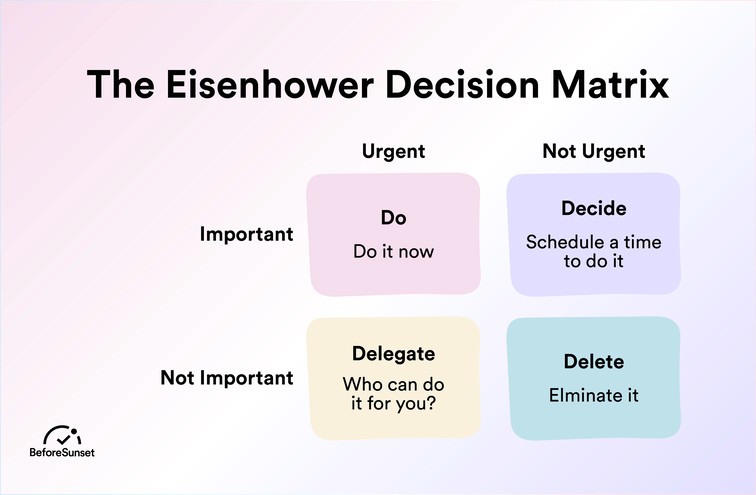
Know when to say NO to meetings
A time management technique that might help you concentrate on your most significant obligations and duties is knowing when to decline appointments. Many meetings can be time-consuming and ineffective, forcing you to neglect your critical job and fall behind on your objectives.
You should think about whether a meeting is directly connected to your goals or obligations and if it is likely to be beneficial or productive before deciding whether it is required. It could be advisable to refuse the invitation or offer an alternate remedy, such as a phone call or email update, if the meeting is not essential if you do not have a clear goal or agenda.
You may give yourself more time to concentrate on your critical job, lessen stress, and increase your overall productivity and effectiveness by refusing to attend meetings that are not directly connected to your objectives or obligations.
Rapid planning method (RPM)
The Rapid Planning Method (RPM) is a time management technique that makes it easier to set and accomplish goals successfully and on schedule. With this technique, you may divide your objectives into manageable steps or stages and then prioritize those activities according to their urgency and relevance.
There are five steps in the RPM process: Listing all of your objectives and responsibilities in one place is the first step. Defining your goals and ideal results is the second stage. The third step is to categorize and rank your actions according to their importance and urgency.
The fourth step is to assess your development and compile a list of any obstacles you've faced. The fifth stage is to put your strategy into action.
Leave buffer time between tasks
A time management technique that might make you more effective and productive at work is leaving a buffer between activities. With this strategy, additional time is allotted before and after each job or appointment to account for unanticipated events or unexpected delays.
By doing this, you may prevent feeling hurried or late, which might stress you out and decrease your performance. Also, buffer time might provide you the much-needed break you need between jobs so you can regroup and be ready for the next one.
You can remain on track, control your stress and anxiety, and accomplish your goals more quickly and effectively by using this time management technique.
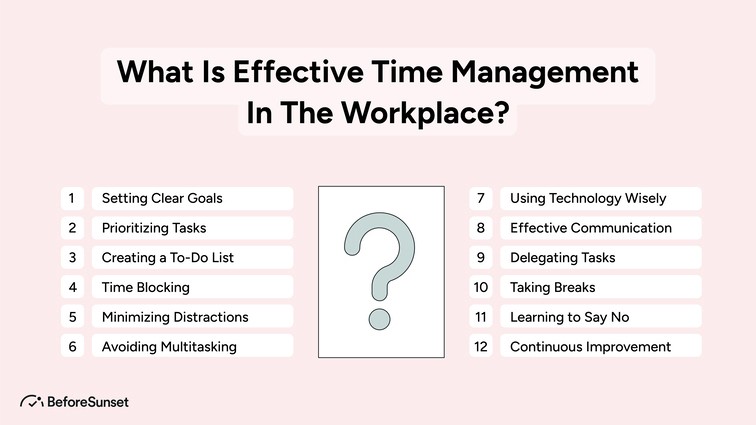
What Is Effective Time Management In The Workplace?
Effective time management in the workplace refers to the ability to prioritize tasks, allocate time efficiently, and focus on essential activities to achieve work-related goals and objectives. It involves using various strategies and techniques to make the most out of the available time, enhance productivity, and reduce stress. Here are some key aspects of effective time management in the workplace:
Setting Clear Goals: Knowing what needs to be accomplished and setting clear, realistic goals is the foundation of effective time management.
Prioritizing Tasks: Identifying the most important and time-sensitive tasks allows employees to focus on what matters most.
Creating a To-Do List: Maintaining a well-organized to-do list helps individuals stay on track and avoid overlooking essential tasks.
Time Blocking: Scheduling specific blocks of time for different tasks or projects helps maintain focus and minimizes distractions.
Minimizing Distractions: Reducing interruptions and distractions in the workplace can significantly improve productivity.
Avoiding Multitasking: Focusing on one task at a time rather than juggling multiple tasks simultaneously enhances efficiency.
Using Technology Wisely: Leveraging productivity tools, project management software, and calendar apps can streamline work processes.
Effective Communication: Clear communication with colleagues, superiors, and subordinates helps set expectations and avoids misunderstandings.
Delegating Tasks: Delegating tasks to team members with the appropriate skills and capabilities can free up time for more critical responsibilities.
Taking Breaks: Encouraging employees to take regular breaks helps prevent burnout and promotes overall well-being.
Learning to Say No: Knowing when and how to decline additional tasks or projects that would overburden an individual's workload.
Continuous Improvement: Regularly assessing time management strategies and adapting to changing work demands ensures ongoing improvement.
What Is The Pickle Jar Theory?
Setting priorities and managing your time are concepts that are explained using the metaphor of the pickle jar theory. It is frequently cited as an example of excellent task and responsibility management. According to the notion, you should see your time and tasks as things that must be put into a pickle jar, which stands in for the finite amount of time in a day or other defined period.
The Pickle Jar Theory operates as follows:
Imagine having a big, empty pickle jar filled with various objects of varying sizes that stand in for your chores, obligations, and commitments. Water, sand, pebbles, and rocks can all be used to symbolize the goods.
Rocks: These are the most vital and crucial activities of your life, rocks. They stand in for your long-term objectives, significant undertakings, or important duties. To make sure they fit, the rocks should first be put into the pickle jar.
Pebbles: Pebbles are little commitments and actions that help you achieve your long-term objectives. They stand for jobs that are necessary but less urgent. You may fit the pebbles around the rocks once you've put them in the jar.
Sand: Sand is a metaphor for the less significant, lesser daily duties that yet demand your attention. These might be simple responsibilities or everyday activities. The spaces between the rocks and pebbles can be filled with sand.
Water: Water represents the insignificant, unimportant aspects of life—activities that don't greatly advance your objectives or general wellbeing. The rocks, pebbles, and sand won't fit in the jar if it is filled with water.
The main takeaway from the Pickle Jar Theory is that you can cram everything into your limited time if you prioritize the major chores (rocks) first, followed by the less important ones (pebbles), and lastly the minor activities (sand). However, you won't have enough time to do what really matters if you start by concentrating on the less important activities (sand) and ignoring the vital ones (rocks).
The Pickle Jar Theory stresses the benefits of prioritizing tasks, using your time effectively, and finding space for activities that actually support your objectives and core beliefs. You may achieve a balance between important obligations and other everyday tasks by setting priorities well, which will increase your productivity and happiness.
You might also like:
Daily Calendar Planner: Your One-Stop Shop for Crushing Every Day
Doing the Opposite of Procrastination: Learn How to Cope With It Professionally
Mastering Time Management: The Key to Success
In today's fast-paced world, where demands constantly tug at our attention, mastering time management has become synonymous with achieving success.
Whether you're striving for personal growth, professional excellence, or a balanced lifestyle, effective time management is the linchpin that holds it all together.
Successful individuals like Elon Musk understand the profound impact of scheduling time wisely. They recognize that time is a finite resource and leverage it judiciously to accomplish their goals.
By allocating time blocks for critical tasks, they ensure that important responsibilities are tackled efficiently.
Daily tasks can easily overwhelm us if not managed properly. Hence, having a structured daily schedule is paramount.
Prioritizing tasks based on their importance and allocating specific time slots for each activity helps maintain focus and productivity throughout the day.
Moreover, successful people understand the significance of syncing their daily schedule with their body's natural rhythms.
They identify their most productive time of day and allocate it for tackling demanding tasks that require peak mental performance. By doing so, they maximize efficiency and optimize results.
Utilizing a time management method that resonates with your workflow is crucial. Whether it's the Pomodoro Technique, time blocking, or another productivity technique, finding what works best for you is key.
Experiment with different methods until you discover the one that enhances your productivity and keeps you on track.
Incorporating productivity apps and online calendars into your daily life can streamline organization and task management. These tools serve as virtual assistants, reminding you of deadlines, scheduling appointments, and keeping your daily goals in sight.
Successful individuals also recognize the importance of personal time amidst their busy schedules.
They understand that nurturing relationships, pursuing hobbies, and maintaining a social life are essential for holistic well-being. By scheduling personal time on a regular basis, they ensure a healthy work-life balance.
Poor time management can be detrimental to both personal and professional life. It can lead to missed deadlines, increased stress levels, and overall inefficiency. Hence, it's imperative to set time limits for tasks and adhere to them rigorously.
Challenging tasks can often seem daunting, but successful individuals approach them with a strategic mindset. Breaking down complex projects into smaller, more manageable tasks and tackling them systematically is a proven strategy for success.
Consistency is key to effective time management. Successful individuals don't view productivity as a one-time endeavor but as a habit cultivated through regular practice. They incorporate study sessions, weekly schedules, and daily routines into their lifestyle to maintain momentum and drive towards their goals.
Motivational speakers often emphasize the importance of setting and achieving daily goals. By setting realistic targets and celebrating small victories along the way, individuals stay motivated and committed to their long-term objectives.
In conclusion, mastering time management is the cornerstone of success in both personal and professional life.
By implementing a structured daily schedule, prioritizing tasks, and utilizing productivity techniques, individuals can optimize their productivity and achieve their goals. So, take control of your time, and watch as your success unfolds.
Unlocking Time Management Mastery with BeforeSunset AI
These days finding a solution that not only assists in managing time but also prioritizes the human aspect of productivity is a rare gem.
Enter BeforeSunset AI, a mindful productivity tool designed to empower individuals in crafting the perfect schedule tailored to their unique needs. Let's delve into how BeforeSunset AI makes time management a breeze:
Time-blocking: BeforeSunset AI seamlessly integrates the time-blocking technique into your workflow. Whether you prefer the guidance of an AI assistant or enjoy constructing your schedule manually, BeforeSunset AI syncs effortlessly with your calendar, allowing you to allocate dedicated time blocks for each task with ease and precision.
Time-tracking: Understanding how you spend your time is essential for optimizing productivity. With BeforeSunset AI, you can start a timer for each task, effortlessly tracking the time invested in various activities. This feature not only provides valuable insights into your productivity patterns but also aids in identifying areas for improvement.
Personal Analytics: Elevating your planning game to the next level, BeforeSunset AI offers a Personal Analytics screen. Here, you can access your productivity score and delve into insightful analytics, empowering you to make informed decisions and refine your planning strategies for maximum efficiency.
AI Assistant: Embrace the future of productivity with BeforeSunset AI's AI Assistant. By harnessing the power of artificial intelligence, this feature automates the planning process, intelligently organizing your day, transforming tasks into actionable items, and even creating subtasks to streamline your workflow. With the AI Assistant at your disposal, planning your day becomes a seamless and efficient endeavor.


